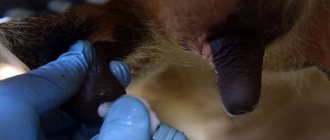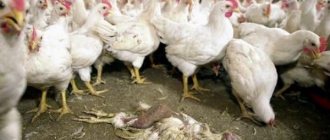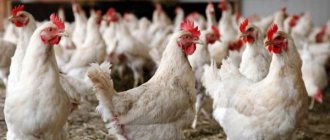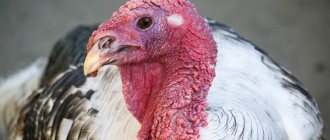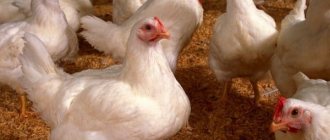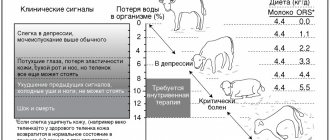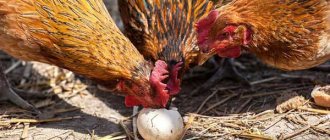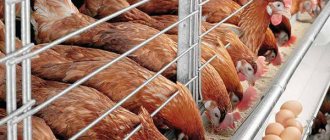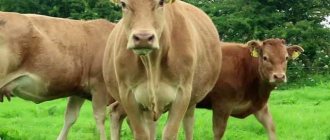Poultry farming » Chickens
0
1531
Article rating
Kira Stoletova
Among chicken diseases, mycoplasmosis is considered one of the most common ailments. This disease develops even with a slight violation of the conditions of detention. Let's consider what symptoms are characteristic of this sore and how to treat it.
Symptoms of mycoplasmosis in chickens and treatment
Characteristics of the disease
Respiratory mycoplasmosis is an infectious disease that affects the respiratory tract of chickens.
The causative agent is Mycoplasma galiseptium, an intermediate form between a virus and a bacterium. After penetration into the respiratory system, it affects the reproductive system and muscle tissue.
Not only adults, but also young individuals at the embryonic stage are subject to infection.
All breeds are susceptible to this disease, but according to statistics, broilers aged 20 to 45 days are more likely to get sick, because they have low immunity.
Roosters are the first to become infected, so the owner needs to pay attention to their appearance and condition. Signs in bettas include coughing, sneezing and shortness of breath.
What diseases are adult broilers susceptible to?
Broiler crosses one month old are also susceptible to various ailments. But even this is not dangerous; often such defects are transmitted to other species of birds kept in the poultry yard, as well as to larger species of animals.
Colibacillosis
The most dangerous defects include colibacillosis. The most dangerous thing is that the provocateurs of this defect are in the environment surrounding the chickens.
And if the poultry farmer allows the slightest non-compliance with the rules of care, then such a defect begins to progress very quickly, affecting absolutely all the internal organs of broiler chickens. This disease can be identified by the following symptoms:
- chickens developed a disorder expressed in diarrhea;
- there is no appetite and a runny nose appears;
- if you touch a sick individual, its body temperature may be elevated;
- the general condition is depressed and in general everything points to the symptoms of a cold;
In order to overcome such a disease, you will need to feed each chicken with an antibiotic. As a rule, it can be biomycin or terramycin.
The best option would be to consult a veterinarian who will recommend the dosage and method of administration. In addition to the antibiotic, you will also need to add a vitamin complex to the feed that the chickens eat.
There should be no sour food in the feeders, and the feeders themselves should be treated daily with a strong solution of potassium permanganate.
Timely vaccination also helps to prevent such a defect. This manipulation is carried out by adding a special drug to the water.
Marek's disease
The next defect to which adult chickens are susceptible is Marek's defect. This disease most often occurs in adult broiler crosses. It is expressed in the following symptoms:
- the iris changes completely and the adult broiler goes blind;
- chickens begin to limp in their legs, and their coordination of movements is completely disrupted;
- often the chicken crop becomes paralyzed, which leads to inevitable exhaustion.
This defect belongs to the group of infectious diseases that can affect the entire nervous system and eyes of a broiler cross. Unfortunately, Marek's defect cannot be treated. And if such a diagnosis is confirmed, then the sick broiler should be immediately sent to slaughter and then burned.
As for preventive measures, the only way that can save you from the attack of this disease is to vaccinate chickens. In addition, if you plan to form a parent tribe from the purchased young animals in the future, then it is worth asking the sellers for a certificate of all the manipulations performed.
The best option would be to purchase a selection of good young stock directly from specialized incubation stations.
Bird flu
Next in line is the most dangerous bird flu. This defect is one of the most dangerous respiratory viruses that affects the digestive organs of chickens and their respiratory tract. The signs by which this disease can be identified are as follows:
- severe diarrhea;
- elevated temperature in broiler crosses;
- general apathy, chickens do not respond to food or drink, refusing them.
Almost all chicken diseases are very dangerous, but this virus is the most severe and cannot be cured. Therefore, sick birds are immediately disposed of by slaughter and burning.
As for preventive measures, in this case only cleanliness of the chicken coop and regular ventilation can prevent the development of this disease.
Chicken pox
And the last of the most common defects to which broiler crosses are exposed is chicken pox. The causative agents of this disease are rodents and other small parasites that live in the feathers of chickens.
This disease can affect all the internal organs of a broiler and its eyes. This disease can be identified by the following symptoms:
- scarlet spots appear on the skin of the chicken, from which scabs subsequently form;
- sick broilers begin to stink;
- a runny nose, difficulty breathing and problems with swallowing appear;
- chickens become weak and move little.
But if you decide to undergo treatment, then in this case you should stock up on the veterinarian’s recommendations and the following medications:
- boric acid;
- furatsilin;
- glazolin.
All of the above drugs are very effective. But they should be used only according to the scheme suggested by the veterinarian.
As a preventive measure, disinfection should be carried out regularly. And in this case, slaked lime will help you. It is with the help of whitewashing that the area where chickens live is cleaned.
Routes of infection
The disease is transmitted by airborne droplets, less commonly through water and food.
Once in the body, the pathogen settles on the mucous membranes of the mouth, eyes, and penetrates the respiratory tract. The peak of development occurs in the autumn, when the weather outside is persistently damp and cold.
The appearance of mycoplasmosis is not affected by the climate of the region. The infection progresses in a herd that is poorly fed and kept in inappropriate conditions. Individuals with weak immunity and low resistance to the bacterium become infected first.
Chicks can become infected from a sick brood hen during the embryonic stage or after hatching through the respiratory system.
Often carriers of the disease are wild birds, as well as domestic chickens living in the neighborhood. Therefore, the walking area must be fenced off to prevent possible contact with them.
Are you here
M. Volkov, V. Irza, T. Chernyaeva, A. Borisov, Federal State Institution “Federal Center for Animal Health Protection” (Vladimir)
The wide distribution of pathogenic and apathogenic mycoplasmas in nature aroused interest in the study of these biological agents - unique microorganisms that occupy the intermediate position between bacteria and viruses. For veterinary medicine, the most interesting among the Mycoplasma genus are Mycoplasma gallisepticum and Mycoplasma synoviae, pathogenic species that cause respiratory mycoplasmosis and infectious synovitis in birds.
Its causative agent is a polytropic microorganism with primary localization in the mucous membranes of the respiratory tract with subsequent spread to other organs and tissues. M. synoviae can be isolated from organs and tissues of the respiratory system, kidneys, liver, spleen, brain and joints. Mycoplasmas are parasites of cell membranes; they disrupt normal cell metabolism, deplete their energy reserves, and cause inflammatory processes. In association with other infectious agents they contribute to chronic respiratory diseases (CRD). Their immunosuppressive effect on the body leads to the depletion of natural resistance, to cytodestructive changes in immunocompetent cells, which activates bacterial and viral infections and the associated course of mycoplasmosis.
Infectious synovitis is a disease of young chickens and turkeys, characterized by arthritis, tenosynovitis, inflammation of the synovial membrane of the joints, and anemia. Recently, it more often occurs in the respiratory form, especially in broilers. Under natural conditions, young chickens and turkeys aged 4-12 weeks are most susceptible to it. The incubation period under natural conditions lasts from 11 to 21 days. Unlike respiratory mycoplasmosis, this disease spreads faster.
M. synoviae has a tropism for epithelial tissues, which contributes to infecting the synovial membranes of joints. The main factor in the pathology of mycoplasma synovitis is the autoimmune reactions of the host organism. Thus, infection caused by M. synoviae is characterized by a progressive effect on the disorganization of connective tissue. Landman and Feberwee's research papers describe a close relationship between amyloid arthropathy and M. synoviae infection in broiler flocks. The disease is accompanied by degeneration of articular cartilage and amyloid degeneration of internal organs, which is a consequence of autoimmune processes.
The source of the infectious agent is sick or recovered birds, as well as hatching eggs. Mycoplasmosis is characterized by a latent course under good housing conditions and high-quality feeding of poultry and long-term persistence in the body. The use of antibiotics and vaccine prophylaxis lead to clinical well-being, but often this does not contribute to the complete elimination of the pathogen from sick chickens. The latent form of infection becomes acute under the influence of various unfavorable causes. Irritants may alter the shedding and transmission of M. synoviae. The manifestation of the disease is facilitated by disturbances in temperature and humidity conditions, vaccination against viral infections, overcrowding of poultry, increased concentrations of ammonia and dust in the room, imbalance of the diet in essential amino acids and minerals, etc.
An important point in the epizootology of infectious synovitis is that among strains of M. synoviae there is great variability in virulence and tissue tropism, which leads to different forms of the disease. Hereditary characteristics, age, immune status of the host, as well as intercurrent infections (infectious bronchitis of chickens, Newcastle disease, colibacillosis, respiratory mycoplasmosis) cause mutually reinforcing pathogenic effects.
In world practice, the preferred method of combating mycoplasmosis is to obtain and maintain the status of birds “free from Mycoplasma”, that is, to completely eliminate the infection and create conditions for the impossibility of its manifestation. However, in practical conditions this is difficult to achieve. In Russia, there are no special federal programs to combat poultry mycoplasmosis in poultry farms; they are in the development stage. There are regional instructions and guidelines for eradicating infections. As a rule, the strategy for the control and prevention of mycoplasmosis is determined by farm veterinary specialists. Timely diagnosis helps prevent the spread of the disease. However, the final diagnosis of infectious synovitis can only be made by laboratory methods. It is considered confirmed if a type of pathogenic mycoplasma is isolated and identified or genetic material and antibodies to the causative agent of the disease are found in samples of biological material from unvaccinated livestock. For rapid diagnosis in poultry farm laboratories, the droplet agglutination reaction is used. Commercial antigens are available on the biological products market to detect antibodies in blood serum to M. synoviae (FSI "ARRIAH", Intervet, Spafas, etc.). In a short period of time, it is possible to examine the required number of blood serum samples in RA, without using special expensive equipment and labor-intensive methods. Confirmatory tests are RA in dilutions, RTGA and ELISA. To detect genetic material in biological material, a sensitive and highly specific polymerase chain reaction is widely used.
The main element in the fight against this disease is the impact on the driving forces of the epizootic chain in order to break its links: adult bird→egg→chickens. It is believed that the main route of transmission and spread of mycoplasmas on the farm is transovarial (through the hatching egg). There is also a horizontal route of transmission of the pathogen. Pre-incubation drug treatment of eggs is one of the ways to combat infection, aimed at breaking the epizootic chain. There are several methods: short-term heating of eggs before incubation to 45.5 ° C; immersing them in different mycoplasmocidal solutions; temperature differential; injection method of introducing antibiotics into eggs, etc. It should be noted that many consider heat treatment of eggs for disinfection from mycoplasmas to be an unacceptable method, since the hatchability of chickens is reduced by up to 30 percent. In disadvantaged farms, from the first days of life, chickens are given antibiotics from the groups of fluoroquinolones, macrolides or tetracycline, followed by the administration of probiotics.
Signs
The incubation period lasts about 3 weeks. At the same time, infected individuals who do not show any signs of infection are carriers of the virus.
Within 2-4 weeks, all livestock in domestic or industrial farming are exposed to the disease.
Symptoms of mycoplasmosis vary depending on the stage and degree of progression.
- At the initial stage of development, the sore is hidden and it is almost impossible to identify it. The pathogen spreads throughout the body, penetrating muscle tissue and blood.
- The second phase is accompanied by a slight deterioration in the condition - lethargy, loss of strength, sneezing, inactivity and loss of appetite. Such symptoms appear, as a rule, in 10-12% of infected individuals, while the rest are asymptomatic.
- The third degree of damage occurs with characteristic problems - complete refusal to feed, coughing, intermittent breathing, excessive salivation and the appearance of foam from the beak. The bird's body begins to show maximum resistance. Other signs include redness of the area around the eyes, swelling of the eyelids, wheezing, diarrhea with the release of liquid green or yellow droppings.
- At the fourth stage, the symptoms become dull and the infected individual becomes an active carrier of the infection.
During periods of dampness, cold and sudden temperature changes, symptoms worsen.
Signs in laying hens
In laying hens, the above-described signs are accompanied by others:
- severe damage to the cornea;
- inflammation of the oviduct;
- decrease in productivity by 15%;
- increase in the number of unfertilized eggs by 30%;
- cases of embryo death are increasing by 25%.
Symptoms
The incubation period of the disease lasts a long time - from 2 to 4 weeks, so the infection can cover 100% of the population. The disease itself is slow and chronic.
There are four stages of development of mycoplasmosis with corresponding symptoms:
The first stage is hidden. The virus spreads latently in the chicken's body.
Second stage - 5-10% of sick birds show the first signs:
- poor appetite;
- apathy;
- lethargy;
- decreased growth rate;
- diarrhea of uncharacteristic color: yellow or green.
Find out why domestic chickens die.
The third stage is active, in which the bird’s body resists the disease. At this time, the main symptoms appear:
- sneezing;
- dyspnea;
- mucus discharge from the nostrils;
- swelling of the eyelids;
- breathing becomes difficult.
- eyes turn red.
Laying hens may also show other symptoms:
- egg production decreases;
- the number of eggs that are unfertilized increases;
- many embryos die;
- the cornea of the eye becomes inflamed.
The fourth stage is a decrease in the active stage, symptoms decrease, and the disease enters the chronic stage.
A chicken that has recovered from the disease remains a source of the virus for a long time, including for its offspring.
Causes
Mycoplasmosis in broilers and chickens can occur for several reasons.
- Dirty drink in the drinking bowl.
- Presence of dangerous insects in the chicken coop.
- Poor quality food through which the virus is transmitted. For each breed, a specific diet is selected to saturate the body with minerals, vitamins and all the components necessary for life. Feeders should be cleaned regularly and food debris removed.
- Weak immune system.
- Genetic susceptibility to the pathogen.
- Stressful situations - moving livestock to another habitat or long-term transportation.
- Vaccination of young animals with live vaccines.
- Violation of temperature and ventilation conditions in the chicken coop.
- Air pollution, the presence of large amounts of dust, ammonia and other harmful and toxic substances.
Pathological changes
Are as follows:
- the corpses of adult individuals are emaciated , and those of young animals are underdeveloped;
- around the nasal openings, and often inside, there are crusts of dried mucus;
- ears, comb and earrings are bluish;
- the skin of the metatarsus and beak are pale in color;
- the mucous membrane of the trachea is hyperemic and riddled with small hemorrhages , its lumen is filled with exudate;
- there are nodules and compactions in the lungs;
- in the heart there is increased blood supply and an increase in the amount of fluid in the pericardial cavity;
- granular lesions of the liver, kidneys and myocardium;
- foci of necrosis in the liver.
Diagnosis
This disease can be identified in chickens or adults through correct diagnosis.
The symptoms described above are similar to other diseases of birds - pneumonia, colds, pasteurellosis, hemophilia, colibacillosis and bronchitis.
Only an experienced veterinarian can make an accurate diagnosis, eliminating the possibility of these diseases.
The bird is examined in several ways:
- blood serum is collected to determine the agglutination reaction;
- take mycoplasma secretions for a smear using a Petri dish filled with agar;
- Gene polymer chain reaction analysis, which helps determine the genetic predisposition of a bird before infection.
Diagnostics
Diagnosis of respiratory mycoplasmosis is difficult, because the presence of the pathogen or antibodies in the blood can also be observed during a latent course of the disease without any clinical signs - the so-called “carrier”.
To control the spread of mycoplasma on the farm, an intravital diagnostic method, the serum-droplet agglutination reaction, has become widespread. Using a special diagnostic kit, you can determine directly on the farm how widespread mycoplasmosis is in the herd.
When making a diagnosis, it is necessary to exclude diseases such as:
- hemophilia (contagious runny nose);
- pneumovirus infection;
- infectious bronchitis of chickens.
As for colibacillosis, in most cases mycoplasmosis and colibacillosis occur together. At autopsy, a characteristic feature of birds that have died from such a “cocktail” is the accumulation of cheesy masses or even dense “remnants” in the air sacs.
Do not confuse respiratory mycoplasmosis with another disease - infectious synovitis. It is caused by another type of mycoplasma - mycoplasma synovia and primarily affects the joints.
Treatment methods
We treat chickens with antibiotics
Depending on the age of birds, different treatment options for mycoplasmosis are used.
Chickens
After diagnosis, sick individuals are isolated - placed in a separate room with clean and dry bedding, as well as fresh water and dry food.
Young animals are treated with antibacterial drugs. The medicine is administered intramuscularly.
Several remedies showed the greatest effect:
- Enroflon - 1 ml;
- Thylazine - 0.5 g;
- Tilan - 0.5 g;
- Enroflox - 1m;
- Farmazin - 1 g;
- Pneumotil - 3 ml.
This dosage is calculated for 1 liter of warm water. The treatment regimen, frequency and quantity of drug administration are calculated according to the weight and age of the bird and in accordance with the instructions on the package.
In isolated cases of infection of resettled broilers and chicks of other breeds, they are treated with one of the drugs - Lilocolin AF, Tilanik, Tilobel or Tialong.
Adults
If the diagnosis has not been established, it is necessary to treat the adult bird with one of the broad-spectrum antibacterial drugs - Avimutin hydro, Tetracycline, Eriprim or Tylodox.
For vague symptoms, antiviral and antibacterial agents are used:
- Eriprim - 1 g;
- Macrodox 200 - 1 g;
- Gilodox - 1 g;
- Hydrotriprim - 1 g.
The dosage is calculated per liter of water.
After making an accurate diagnosis, special drugs are used that treat mycoplasmosis - Tialong, Tylosin or Tilocolin AF. The regimen and frequency of therapy according to the instructions.
At an advanced stage of infection, infected individuals are sent for slaughter, because it is impossible to cure the disease.
Respiratory form
Treatment of the respiratory form in chickens and adults is carried out with the help of highly targeted antibiotics - Farmazin, Enroxil, Tilsolom or Tilmicovet.
It is effective to use the following scheme: 1 g of substance per 1 liter of water. All livestock need to be watered, regardless of their condition and appearance.
Additionally, indoor air sanitation is required in the presence of birds, and the chicken coop is treated with aerosol disinfectants:
- lactic acid (30% concentration) - 10 ml;
- Monclavite - 3 ml;
- Iodotriethylene glycol - 0.7 ml;
- Ecocide - 0.15 g.
The quantity is calculated for spraying an area of 1 m³.
Dangerous infections: will Brovafom New help?
Mycoplasmosis and bursal disease are also treated with Brovafor New. The drug is a complex of powerful antibacterial components that have a complex effect on the entire body. Since the medication is aggressive in its effects, it is recommended to give it to poultry only after consulting a doctor.
Brovafom consists of three main components:
- oxytetracycline, which destroys the bonds between bacterial proteins, making their further reproduction impossible;
- colistin, the action of which is aimed at destroying the integrity of the cytoplasm in the cells of gram-negative bacteria;
- trimethoprim, which suppresses the division of harmful bacteria and creates an unfavorable environment for them.
Brovafom new is used to treat any severe infections in poultry and livestock
It is allowed to take the drug in two regimens that show equally high results. The first option involves diluting 1 kg of powder in a liter of water, the second - diluting 1.5-2 kg of the mixture in 1 kg of feed. Diluted water or food is left in the feeders so that the birds have constant access to them. Therapy continues for three days, in severe cases - 5 days. If the chosen treatment regimen does not produce a quick effect, after consultation with a doctor, it is allowed to extend it up to two weeks.
Brovaform quickly suppresses bursitis in birds
Attention! Brovaform New penetrates into tissues and eggs, so you should not consume these products for a week after finishing the course of treatment. Ideally, it is recommended to abstain from this for at least 10-15 days.
Video - The most dangerous diseases in chickens
Preventive actions
By following simple preventive measures, you can keep your chickens healthy and productive.
- To prevent infection with mycoplasmosis, birds are given Furacycline at the rate of 0.5 g per kg of body weight, in parallel with the drug Immunobak - three doses per bird. These drugs are administered orally in the morning and evening for five days. Preventive measures are carried out three times - in individuals aged 4, 5 and 10 months.
- Vaccinating chickens against disease at an early age.
- Balanced feeding, providing birds with fresh and clean water, regular cleaning of the chicken coop. Change the litter once a year and burn it.
- Annual disinfection of the chicken coop with a solution of formalin or sodium hydroxide 2% concentration.
- Maintaining stable temperature, humidity and ventilation.
- Periodic inspection of birds for signs of infection and timely quarantine of sick chickens.
- Prevention of overcrowding, which disrupts the microclimate in the chicken coop and increases the likelihood of the appearance of various viruses and bacteria.
Prevention of mycoplasmosis
To prevent the disease, a number of simple preventive measures are carried out that will help avoid mycoplasmosis:
- Maintain a comfortable microclimate in the chicken coop: insulate the room, eliminate drafts, and improve ventilation.
- In winter, improve heating and additional lighting.
- Clean and disinfect the premises regularly. Change contaminated bedding, which can be a source of disease.
- When purchasing hatching eggs, check them for infection. Check for signs of disease in dead embryos.
- New birds should be quarantined and tested for infectious agents.
- In winter, give your birds vitamin and mineral supplements to boost their immunity.
- Regularly treat the chicken coop with insecticides to prevent the appearance of parasites.
- Vaccinate birds using modern high-quality vaccines.
- If the region is considered unfavorable for mycoplasmosis, limit the walking of poultry.
How to quickly and effectively cure a disease
The treatment regimen for the disease is selected by the veterinarian after identifying the pathogen. The infected bird is isolated from the chicken coop, because without quarantine the therapy will not bring any results.
See also
Symptoms and treatment of pasteurellosis in domestic chickensRead
Antibacterial treatment
Small farms provide individual treatment, which includes intramuscular injection of the antibiotic Tylosin. Injections are given once a day for a week.
On large farms, the medicine is added to water or feed. The duration of treatment is determined by the number of sick chickens and the degree of their infection.
For birds, a complex drug such as Furacyclin-M can be prescribed. Its constituent components are Tylosin and vitamin B. To eliminate the disease, antibiotics such as Aureomycin, Streptomycin and Oxytetracycline are selected.
Folk remedies
Alternative medicine recipes are allowed to be used as additional therapy to enhance immunity. It is possible to achieve a positive effect with the help of herbal preparations based on:
- St. John's wort and black elderberry root;
- St. John's wort, chamomile, cornflower and corn silk.
In addition, it is recommended to feed birds with glucose solution and goat milk.
